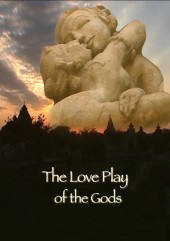The Love Play of the Gods

Bhagawati’s review of Vimlan’s inspirational Khajuraho documentary.
Watching Vimlan’s sublime and sensitive documentary on Khajuraho, the ancient center of the Tantrikas, exquisite memories of my own visit a couple of years ago came flooding back. I could relate to what Vimlan said: “When I first visited the temples of Khajuraho I was deeply in awe. Besides the artistic and architectural grandeur, the thousand-year-old temples radiate an atmosphere of joy, playfulness and celebration often missing in our modern world. I was fascinated by the naturalness, beauty, and sacredness of the lovers displayed on the temple walls. What an extraordinary way of seeing life, especially as compared to the way sexuality is seen in most religions.
The more I studied the meaning of these sculptures, the architecture, and the scriptures of Tantra, the deeper I was intrigued about the intricacy, multidimensionality, and depth of this ancient wisdom.”
The first temple of this extraordinary Tantric site was built in 954 and eventually 85 sandstone temples were erected of which many were destroyed over time. 23 temples survived – most of them are dedicated to Shiva and Vishnu; the main temples are situated on well-kept grounds and are surrounded by flowering bushes and trees, depending on the season of course.
A large part of the documentary was filmed during the annual Shivaratri festival, when thousands of visitors flood the temple area in order to set about their various pujas. Among several experts speaking about Khajuraho’s importance and impact, the film also features Shobita Punja, the eminent art historian and CEO of the National Culture Fund, whose comments are especially enjoyable to listen to.
I watched the video with all the extra features in one go, spellbound the entire time, the pleasure enhanced by beautiful sound tracks – Prem Joshua, Deva Premal and Miten, Manish Vyas, and Shastro. Any review about those magnificent images and well researched apt commentaries pales in view of the actual film.
Osho speaks often about Khajuraho and its significance and the fact that his beloved Nani (grandmother) hailed from there. He also declares that Khajuraho represents the whole philosophy and psychology of the New Man.
“My grandmother was just fifty, at the very peak of her youth and beauty. You will be surprised to know that she was born in Khajuraho, the citadel, the ancient most citadel of the Tantrikas. She always said to me, ‘When you are a little older, never forget to visit Khajuraho.’ I don’t think any parent would give that advice to a child, but my grandmother was just rare, persuading me to visit Khajuraho.
Khajuraho consists of thousands of beautiful sculptures, all naked and copulating. There are hundreds of temples. Many of them are just ruins, but a few have survived, perhaps because they were forgotten. Mahatma Gandhi wanted these few temples to be buried under the earth because the statues, the sculptures are so tempting. Yet my grandmother was tempting me to go to Khajuraho. What a grandmother to have! She herself was so beautiful, like a statue, very Greek in every way.”
Osho, Glimpses of a Golden Childhood, Ch 4
Bhagawati, Osho News
Prem Vimlan was born in Germany and took sannyas in 1983, spending many years at the Osho Commune in Pune. Osho’s insights on Tantra and Khajuraho inspired her to create this documentary which she began filming in 1998, together with Swami Anand Marpa. Intrigued by the magnificent artwork of Khajuraho and by its thousand year old message of Oneness and the sacredness of all life she spent over a decade creating this documentary to share Khajuraho’s ancient holistic wisdom.
Vimlan works as a gardener and lives at Harbin Hotsprings in California.
Available at www.theloveplayofthegods.com
- Log in to post comments
- 237 views
